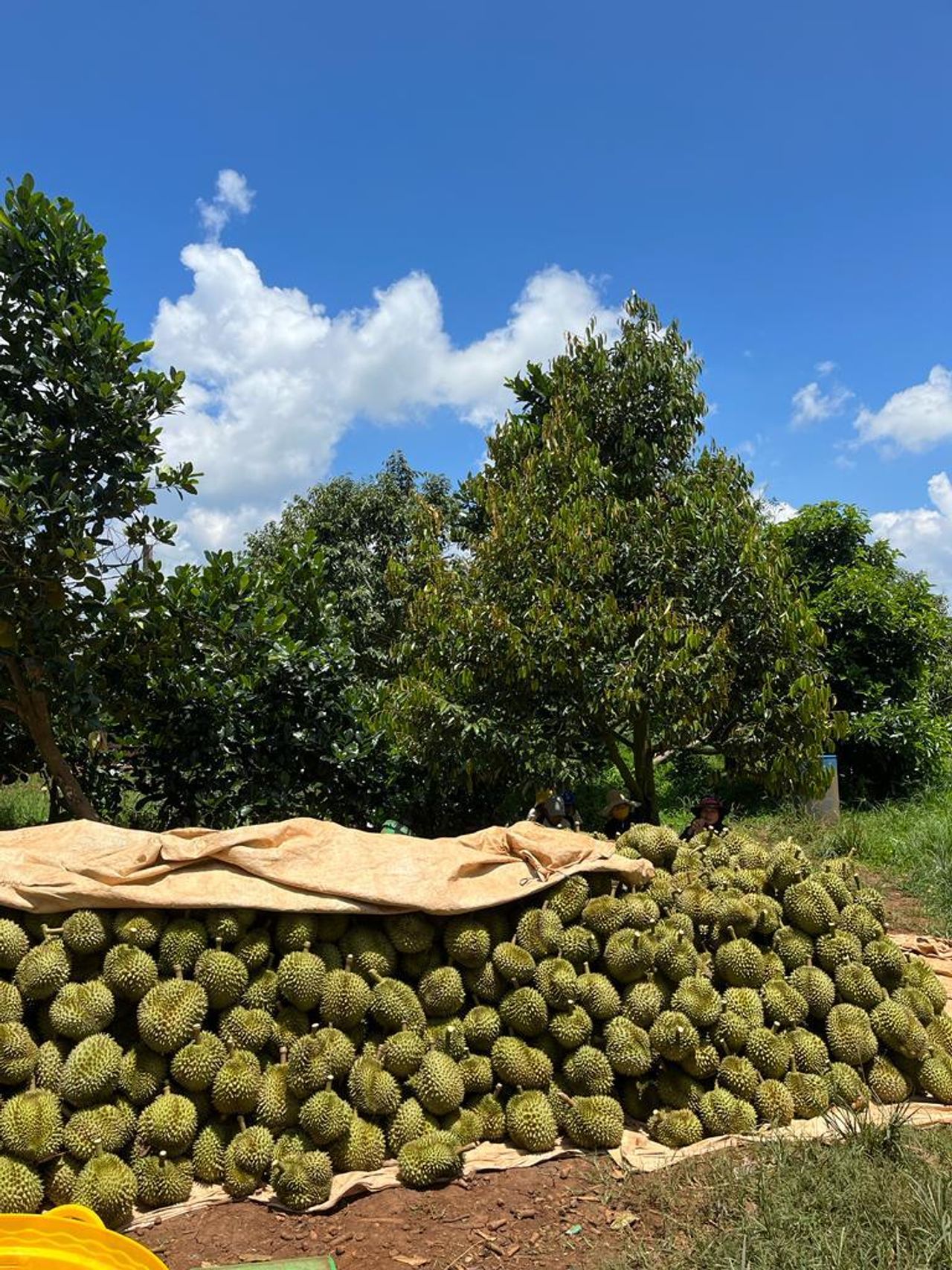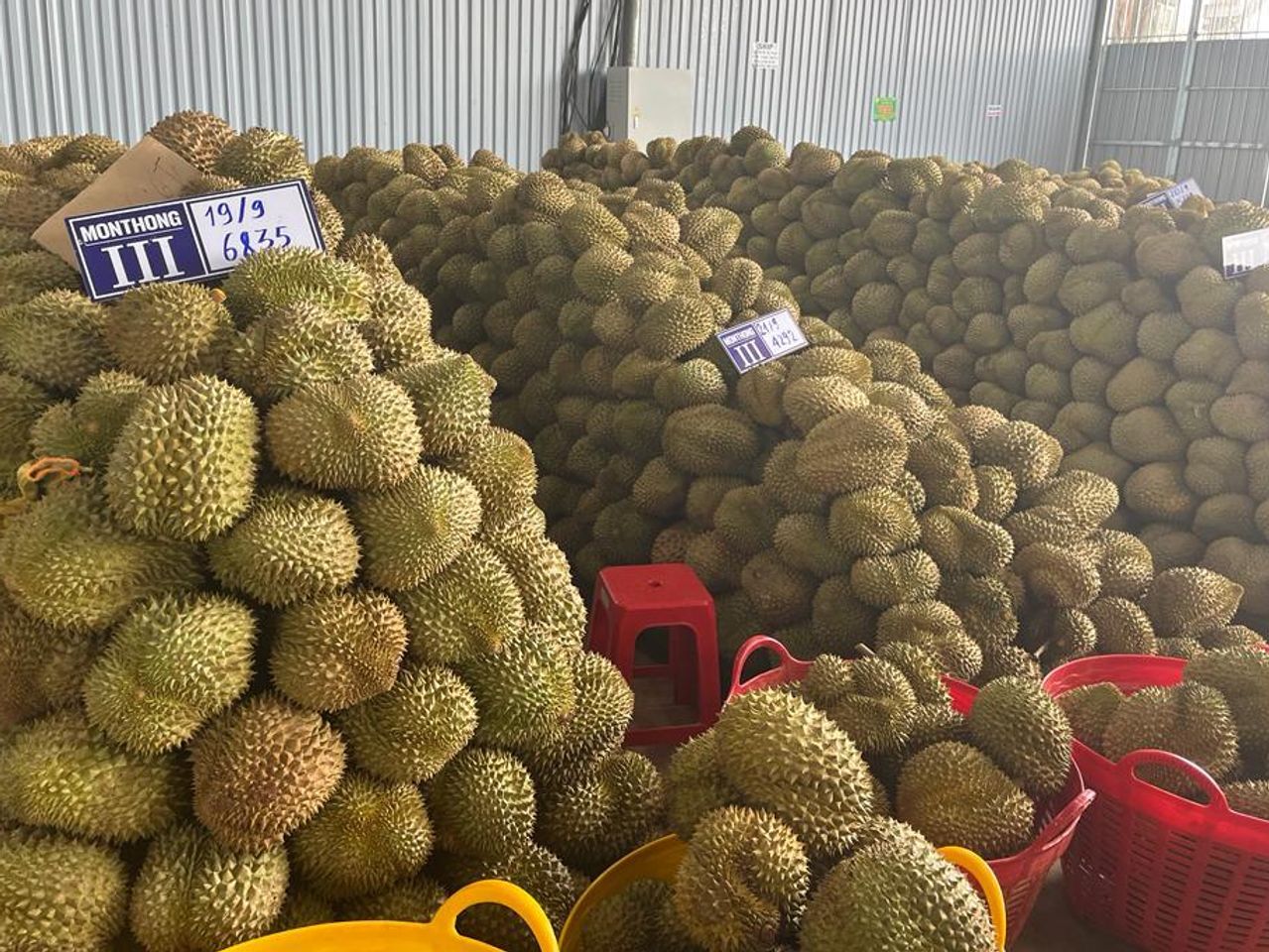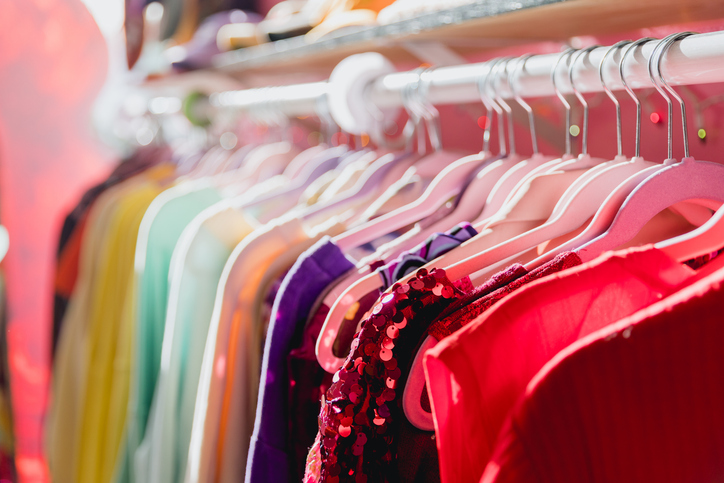As Chinese Tastes Change, Farmers Everywhere Rip Up and Replant
The windfall is transforming entire regions, but some are starting to worry: What if China stops buying?
EA YONG, Vietnam—In the verdant highlands of central Vietnam, warehouses the size of airplane hangars dominate small farming towns, bristling with mounds of tropical fruit. The bounty is destined for a colossal market: China.
Farmers are felling coffee trees traditionally grown in this cool hilly region to plant spiky durians, pungent fruits that have become wildly popular in China. They are reaping the windfall to buy new irrigation systems, pay off loans and build shiny marble facades to their homes.
“We locals aren’t just doing well, we can even be considered rich,” said Pham Van Trung, 54, as he ate a late lunch of pork and rice wine. Trung made $81,000 this year selling durian, and said the region was swarming with Chinese buyers.
China’s appetite for foreign produce has grown in recent decades along with the wealth of its consumers. The amount of food the world’s second most populous nation imports has risen to over $200 billion a year—more than any other country—from about $15 billion two decades ago, according to the World Trade Organization. Avocado farmers in Kenya, shrimp cultivators in India, soy producers in Russia and banana growers in Cambodia are all cashing in.
While economic growth in China has slowed recently and its population is shrinking, demand for nutrient-rich foods such as beef and tropical fruit has remained high.
Last year, the Chinese noshed through more than 800,000 metric tons of imported durian and nearly six million metric tons of imported meat—both world-leading totals. It bought 90 million metric tons of soybeans from overseas last year, accounting for roughly 60% of global trade, for use in making tofu and to feed the country’s hundreds of millions of pigs.
Feeding China’s massive middle class presents a historic opportunity for countries seeking to boost the incomes of people in poor, rural areas. But it also poses a quandary: how to tap in to its huge market without becoming dependent on a trade partner that can be fickle.
In recent years, China has restricted imports of Norwegian salmon, Taiwanese pineapples, Philippines bananas and Australian lobsters. It usually cites contamination, pests or issues with quality—but Beijing’s curbs have also often coincided with political disputes.
China slapped hefty antidumping duties on Australian wine exports in 2020 after Australia called for an independent probe into the origins of Covid-19. In 2012, China halted purchases from banana growers in the Philippines, saying mealybugs had been discovered in shipments, after a flare-up between the countries in the South China Sea.
“With the size of the Chinese economy, it can always use trade to punish an exporter,” said Yun Sun, director of the China program at the Stimson Center, a think tank in Washington, D.C. Selling to China is “an opportunity, and it is a risk,” she said.
The risk is higher because when the chance to export to China’s massive market opens up, often entire agricultural belts go all in. This can lead to what Sun calls “singularification,” or the concentration of a local economy around one product, making it vulnerable to disruption.

That is what appears to be happening in Vietnam’s central highlands. The region is famed for its Robusta coffee, which is sold around the world. But last year, Beijing opened the gates to large-scale imports of Vietnamese durian—and farmers here began uprooting their coffee crops. Traders flocked to snap up the produce, causing local prices to more than double this year.
Be Duc Huynh, a 26-year-old farmer who got rid of his entire coffee crop, said he makes about five times as much from a hectare of durian as he earned from coffee. He harvested four tons of durian this year, up from one ton last year—all of it destined for China.
China buys around 90% of durian exports from Vietnam, which also sells much of its dragon fruit, bananas, mangoes and jackfruit to its giant neighbour. In recent months around 60% of Vietnam’s fruit and vegetable exports have gone to China, up from one-third a decade ago, according to official figures compiled by data provider CEIC.
During the autumn harvest time, the village air carried the sharp smell of the fruit. Families stacked mounds of durian in front of their homes to entice traders, who thwacked the durian shells with knife handles to test for quality. Hard means it is too young; soft means it is ripe and can sell for a higher price.
On a recent afternoon, durian trader Nguyen Thai Huyen dug into the flesh with her painted-pink fingernails, tasting bits of durian to determine their ripeness. Huyen posts snappy videos on TikTok of her visits to plantations and the mountains of durian she has on offer.
“A few years ago people considered durian a crop to reduce poverty,” she said. “Now it is the million-dollar crop.”
She has tried selling to Japan, but said buyers there only take small amounts. She isn’t especially worried about being too reliant on China, though. She says durian’s popularity has room to grow in the country, where many are still unfamiliar with the fruit.
Vietnam’s government is less certain. Earlier this year the agriculture ministry issued a warning about what state media called reckless durian cultivation, saying many farmers were abandoning traditional crops such as coffee and rice and planting durian in areas unsuited to it. Agriculture experts cited in state media have encouraged farmers to develop alternative markets to China and try to sell more of their produce locally.
Traders say that is easier said than done. The fruit has few takers outside of the region, and recent high prices put durian out of reach of many local Vietnamese.
Still, farmers say they want to be careful. In September, some fruit exports including durian were halted after Beijing complained about mealybugs and other pests. It reminded farmers of a major disruption in January 2022 when truckloads of Vietnamese produce rotted after China sealed off its southern border to contain the spread of Covid-19.
H’Meng, a farmer who goes by one name, has planted hundreds of durian trees in recent years. Now, she said, she is planning to grow more coffee. The prices are more stable, she said, because the market for coffee isn’t focused on one nation.
“I’m worried about becoming too dependent on China,” she said.
 Copyright 2020, Dow Jones & Company, Inc. All Rights Reserved Worldwide. LEARN MORE
Copyright 2020, Dow Jones & Company, Inc. All Rights Reserved Worldwide. LEARN MORE
This stylish family home combines a classic palette and finishes with a flexible floorplan
Just 55 minutes from Sydney, make this your creative getaway located in the majestic Hawkesbury region.
Continued stagflation and cost of living pressures are causing couples to think twice about starting a family, new data has revealed, with long term impacts expected
Australia is in the midst of a ‘baby recession’ with preliminary estimates showing the number of births in 2023 fell by more than four percent to the lowest level since 2006, according to KPMG. The consultancy firm says this reflects the impact of cost-of-living pressures on the feasibility of younger Australians starting a family.
KPMG estimates that 289,100 babies were born in 2023. This compares to 300,684 babies in 2022 and 309,996 in 2021, according to the Australian Bureau of Statistics (ABS). KPMG urban economist Terry Rawnsley said weak economic growth often leads to a reduced number of births. In 2023, ABS data shows gross domestic product (GDP) fell to 1.5 percent. Despite the population growing by 2.5 percent in 2023, GDP on a per capita basis went into negative territory, down one percent over the 12 months.
“Birth rates provide insight into long-term population growth as well as the current confidence of Australian families,” said Mr Rawnsley. “We haven’t seen such a sharp drop in births in Australia since the period of economic stagflation in the 1970s, which coincided with the initial widespread adoption of the contraceptive pill.”
Mr Rawnsley said many Australian couples delayed starting a family while the pandemic played out in 2020. The number of births fell from 305,832 in 2019 to 294,369 in 2020. Then in 2021, strong employment and vast amounts of stimulus money, along with high household savings due to lockdowns, gave couples better financial means to have a baby. This led to a rebound in births.
However, the re-opening of the global economy in 2022 led to soaring inflation. By the start of 2023, the Australian consumer price index (CPI) had risen to its highest level since 1990 at 7.8 percent per annum. By that stage, the Reserve Bank had already commenced an aggressive rate-hiking strategy to fight inflation and had raised the cash rate every month between May and December 2022.
Five more rate hikes during 2023 put further pressure on couples with mortgages and put the brakes on family formation. “This combination of the pandemic and rapid economic changes explains the spike and subsequent sharp decline in birth rates we have observed over the past four years,” Mr Rawnsley said.
The impact of high costs of living on couples’ decision to have a baby is highlighted in births data for the capital cities. KPMG estimates there were 60,860 births in Sydney in 2023, down 8.6 percent from 2019. There were 56,270 births in Melbourne, down 7.3 percent. In Perth, there were 25,020 births, down 6 percent, while in Brisbane there were 30,250 births, down 4.3 percent. Canberra was the only capital city where there was no fall in the number of births in 2023 compared to 2019.
“CPI growth in Canberra has been slightly subdued compared to that in other major cities, and the economic outlook has remained strong,” Mr Rawnsley said. “This means families have not been hurting as much as those in other capital cities, and in turn, we’ve seen a stabilisation of births in the ACT.”
This stylish family home combines a classic palette and finishes with a flexible floorplan
Just 55 minutes from Sydney, make this your creative getaway located in the majestic Hawkesbury region.






















